Intel has released more of its “tick” Broadwell 14nm processors. As with all Intel processor releases these new Broadwell CPUs aim to bring better performance to the servers that use them. Dell has refreshed its PowerEdge R730 servers (review of the R730 before the refresh) and has run a series of benchmarks to highlight the difference customers can expect from the updated processors. Dell was nice enough to share their testing and results with us but we are always more inclined to run our own tests to see how well something works, which we have, leveraging the Intel Xeon processor E5-2600 v4 product family.
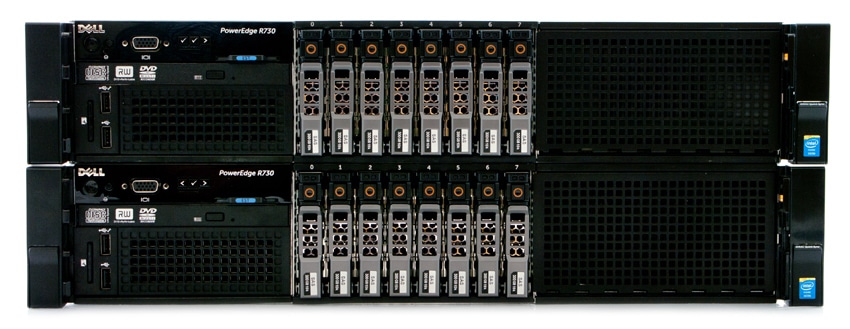
Dell PowerEdge Gen13 with Broadwell specifications:
- Form Factor: 2U
- CPU: Intel Xeon processor E5-2600 v4 product family
- CPU sockets: 2
- Cache: 2.5MB per core (core options 4, 6, 8, 10, 12, 14, 16, 18, 22)
- Chipset: Intel C610
- Memory: up to 1.5TB (24 DIMM slots) DDR4 up to 2400MT/s
- I/O slots: up to 7 x PCIe 3.0 plus dedicated PERC slot
- RAID controllers:
- Internal controllers: PERC S130 (SW RAID), PERC H330, PERC H730, PERC H730P External HBAs (RAID): PERC H830
- External HBAs (non-RAID): 12Gbps SAS HBA
- Drive bays:
- Up to 16 x 2.5” HDD: SAS, SATA, nearline SAS SSD: SAS, SATA
- Up to 8 x 3.5” HDD: SAS, SATA, nearline SAS SSD: SAS, SATA
- Maximum internal storage:
- HDD: SAS, SATA, nearline SAS SSD: SAS, SATA
- 16 x 2.5” – up to 29TB via 1.8TB hot-plug SAS hard drives
- 8 x 3.5” – up to 64TB via 8TB hot-plug NL SAS hard drives
- Embedded NIC: 4 x 1GbE, 2 x 10+2GbE, 4 x 10GbE NDC
- Operating systems:
- Microsoft Windows Server 2008/2012 SP2, x86/x64 (x64 includes Hyper-V)
- Microsoft Windows Server 2008/2012 R2, x64 (includes Hyper-V)
- Microsoft Windows HPC Server 2008
- Novell SUSE Linux Enterprise Server
- Red Hat Enterprise Linux
- Optional embedded hypervisors:
- Citrix XenServer
- VMware vSphere ESXi
- Microsoft Windows Server 2012, includes Hyper-V
Dell ran a series of 5 internal benchmarks on their PowerEdge R730 using the new E5-2699 v4 and E5-2667 v4 CPUs. The benchmarks included SPECint_base2006, SPECfp_base2006, SPECpower, SAP SD 2 Tier (Linux), and SAP SD 2 Tier (Windows). Across the board the refreshed R730s saw a higher percent Uplift compared to the ones with the previous E5-2699 v3 Haswell Processors, with scores ranging from 15% better to 41% better. Full results are detailed in the table below:
| Dell's Refreshed R730s Internal Benchmarks | |||||
|---|---|---|---|---|---|
| Benchmark | Broadwell | Score | Haswell | Score | %UPlift |
| SPECint_base2006 | E5-2699 v4 | 71.3 | E5-2683 v3 | 61.9 | 15.2% |
| SPECfp_base2006 | E5-2667 v4 | 123 | E5-2683 v3 | 106 | 16.0% |
| SPECpower | E5-2699 v4 | 11,868 | E5-2699 v3 | 10,206 | 16.3% |
| SAP SD 2 Tier (Linux) | E5-2699 v4 | 21,050 | E5-2699 v3 | 16,500 | 27.6% |
| SAP SD 2 Tier (Windows) | E5-2699 v4 | 19,300 | E5-2699 v3 | 13,680 | 41.1% |
The results also highlighted the E5-2689 v4 on the R730 with Dell differentiated air-cooled support as the fastest industry processor available.
Application Workload Analysis
For this review we populated a PowerEdge R730 with 512GB RAM (16x32GB) and 6.4TB of NVMe local storage. We tested first with Intel E5-2699 v3 CPUs, then the new E5-2699 v4 CPUs Broadwell processors. Aside from the CPUs and the required BIOS update to 2.0.1, nothing else was changed in the system.
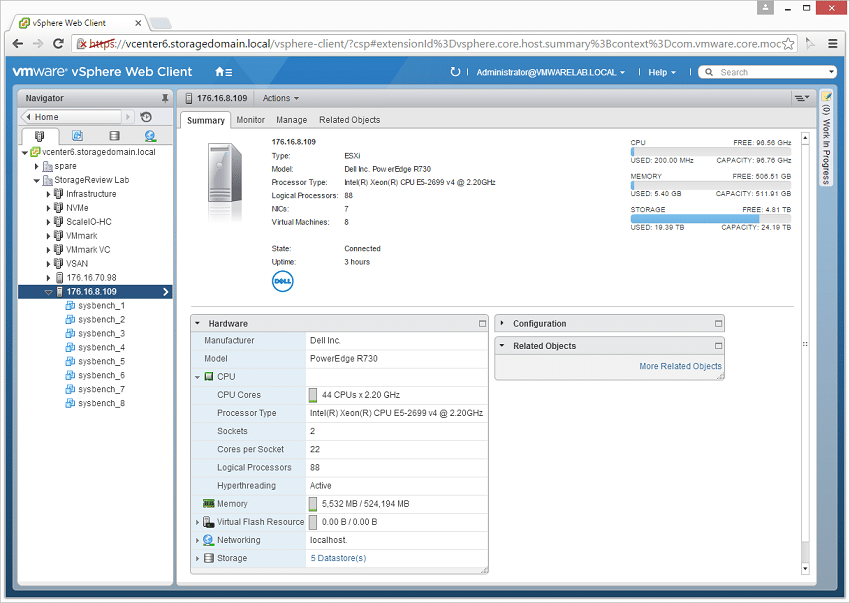
For the comparison we looked at MySQL OLTP performance via SysBench. We will be looking at average transactions per second (TPS), average latency, and worst-case MySQL latency scenario (99th percentile latency).
Looking at performance, the new v4 Broadwell processors bumped performance up to 8,971 TPS from the Haswell 7,690 TPS, or an increase of a little under 17%.
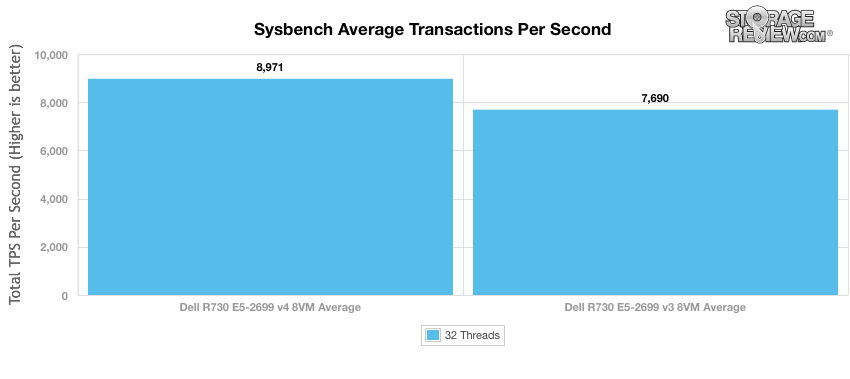
With average latency, the Broadwell processor dropped latency down to 28.5ms from the Haswell 33.3ms, roughly a 15% lower latency.
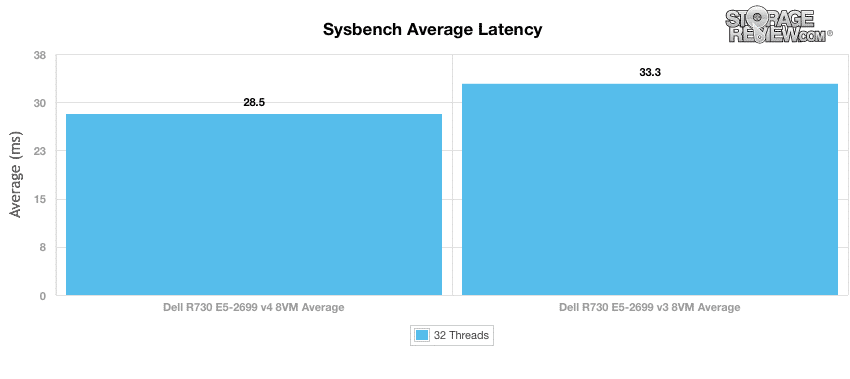
And in our worst-case MySQL latency scenario (99th percentile latency) we saw the Broadwell take latency down to 64ms from the Haswell 69ms or roughly 8% better.
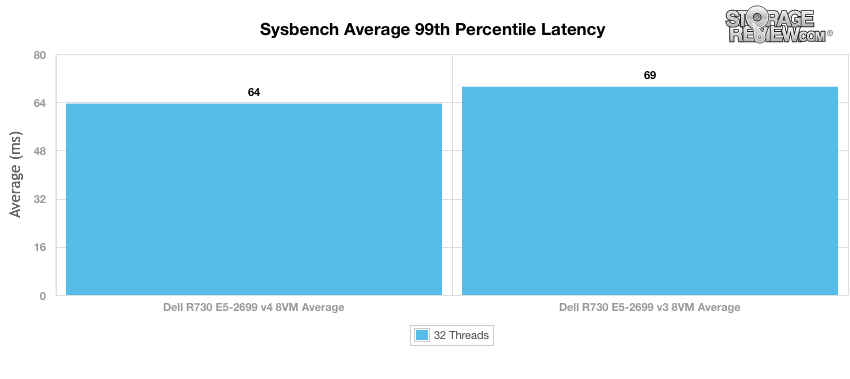
While clearly the results were better across the board, it's interesting to note the CPU utilization during this test. Leveraging the v3 CPUs, we saw the CPUs pegged at 100% during the early stages of the testing, leveling off in the 94-95% range throughout the duration, more or less (in the absence of more RAM) maxing out overall system capabilities. With the Broadwell V4 CPUs, the initial burst also ran up to 100%, then leveled out in the 85% range. In addition to the performance increase, the additional CPU availability indicates there's more room to grow in terms of the application footprint.
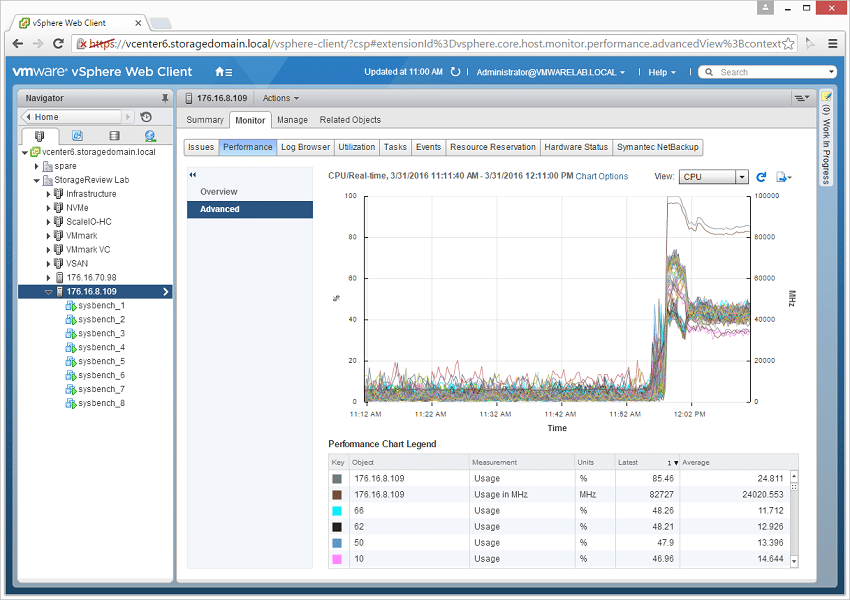
Conclusion
In this case we tested with high-end NVMe flash storage to do our best to stress the CPUs. We tested identical versions of the v3 and v4 CPUs, with nothing else modified in the system, to be sure we're truly seeing the benefits of the new CPUs. Dell's internal numbers showed performance gains of 15%-41% depending on workload. We ran only a single application workload, but found the benefits to be in that range for both transactions per second and latency. What this highlights is that the Intel v4 CPUs have a material impact in the overall server performance. While we saw this with NVMe storage, even more modest server storage and workloads should see a boost.
The Dell PowerEdge R730 was already one of our favorite 2U server platforms for mainstream computing and they make up the core of the load generation segment of our test lab. With the new Intel v4 CPUs, we're able to squeeze out even more performance from the servers, incidentally with a pin-for-pin upgrade that's pretty easy to handle. While most won't be retrofitting their servers with new CPUs, those considering between v3 and v4 CPUs clearly have an easy choice to make if performance is paramount. Beyond performance, we also saw a lower CPU utilization figure under heavy load. This means there's now more room in the CPU for more applications on the server, an additional key metric when evaluating workload scalability in the server.
Bottom Line
The Dell PowerEdge R730 was already a great server; paired with the new Intel v4 CPUs though, it gets even better with a 17% transactions per second increase in our application testing. For those who need the most out of their server platforms, Broadwell adds a lot of value.




 Amazon
Amazon